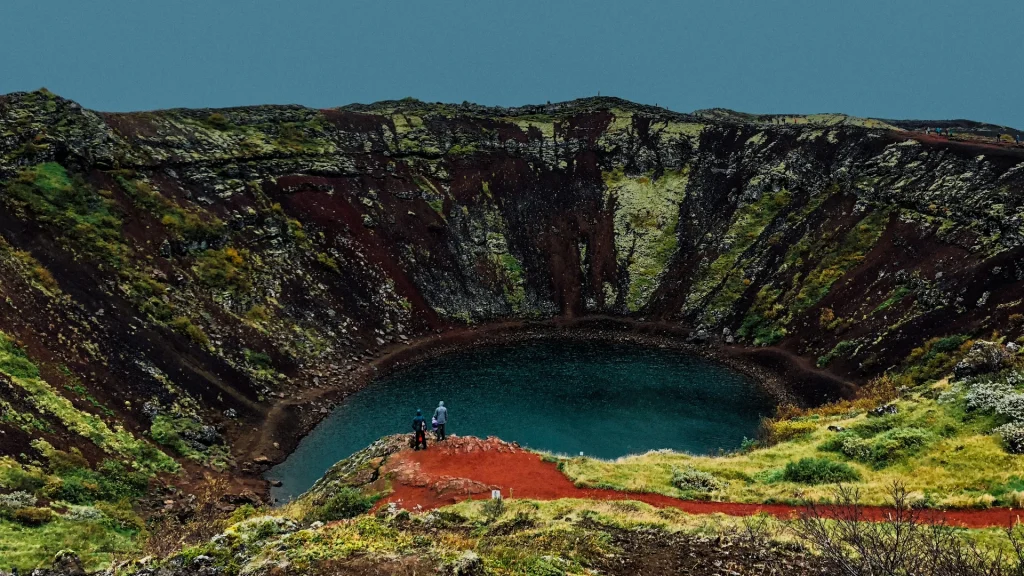Kerið is truly a highlight in Iceland that you shouldn’t miss. The crater is located in the south of Iceland, more precisely in the area known as Grímsnes, and is part of the so-called Golden Circle, a popular route for day trips from Reykjavík.
What makes Kerið so special is its striking appearance. The crater is about 3,000 years old, which is quite young by Icelandic standards. It has an oval-like shape with steep sides and is about 55 meters deep, 170 meters wide, and 270 meters long. What’s really impressive is the brightly blue water of the lake at the bottom of the crater, which contrasts with the red and orange tones of the crater walls. This play of colors is particularly fantastic on a sunny day.

In contrast to many other volcanic craters in Iceland, Kerið was partly formed by the extraction of magma material, not by an explosive volcanic eruption. Over time, the bottom of the crater sank, and a lake formed, whose water level is approximately at the level of the groundwater.
There is a small admission fee to visit the crater, which contributes to the maintenance of the site and the paths. You can walk around the rim of the crater and also hike down to the lake, which I would absolutely recommend.
Formation
The formation of a volcanic crater like Kerið is a fascinating geological process that is essentially related to the activity of magma beneath the Earth’s surface. Here’s a simplified explanation:
Magma Rise: It all begins deep beneath the Earth’s surface, where magma (molten rock) pushes upwards due to its lower density compared to the surrounding solid rock. This process can be triggered by various geological events, such as the movement of tectonic plates.
Eruption and Outburst: When the magma gets close enough to the surface, cracks or weaknesses in the Earth’s crust allow it to be pushed upwards. This leads to a volcanic eruption, during which magma, gases, and ash are expelled from the volcano. Upon reaching the surface, the magma cools and solidifies into lava.
Crater Formation: The classic volcanic crater is formed during such an eruption. The pressure of the materials exiting the volcano creates an opening or “mouth” at the top of the volcano, which we know as a crater. In the case of Kerið, it is believed that the crater was formed by the collapse of the magma chamber after an eruption, as the magma exited the chamber and caused the overlying earth structure to collapse.
Further Developments: After the eruption and the initial crater formation, further geological processes can change the structure and appearance of the crater. In the case of Kerið, for example, the crater gradually filled with groundwater, leading to the formation of the characteristic crater lake.
It’s important to note that not all volcanic craters are formed in the same way. The specific circumstances of the magma composition, geological structures, and the eruption itself can vary greatly and lead to different types of craters and volcanic formations.
Lavafield Grímsneshraun
The Grímsneshraun lava field is an impressive natural spectacle in Iceland that often stands in the shadow of the more famous attractions but is definitely worth a visit. It is located in the Grímsnes region, not far from the famous Golden Circle, a route that includes Þingvellir National Park, the Geysir geothermal area, and the Gullfoss waterfall.
Grímsneshraun is a relatively young lava field created by volcanic activity in Iceland’s recent geological past. The landscape here is characterized by solidified lava that stretches over a large area, forming an unreal, almost moon-like surface. The rough, black lava formations contrast sharply with the bright green of the moss blankets that have settled on the lava over the years. These moss blankets give the landscape a soft, velvety look that becomes especially apparent in damp weather.
Visitors to Grímsneshraun can hike on designated paths and explore the unique flora and fauna that have adapted to these harsh conditions. It is a fascinating example of how nature can transform even the most barren landscapes into something beautiful.
The lava field is also a testament to Iceland’s dynamic geological activity and offers insights into the volcanic processes that have shaped the island. It is a great place for geology enthusiasts and photographers alike, thanks to the impressive landscape and opportunities to capture the rugged beauty of Iceland.
No Comments Yet